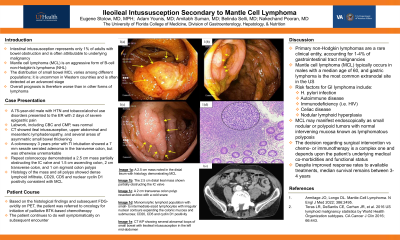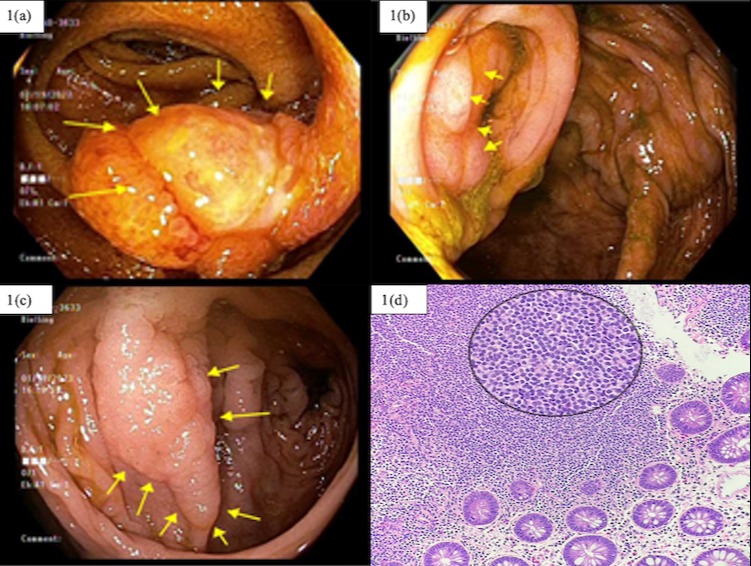Monday Poster Session
Category: Small Intestine
P2691 - Ileoileal Intussusception Secondary to Mantle Cell Lymphoma
Monday, October 23, 2023
10:30 AM - 4:15 PM PT
Location: Exhibit Hall

Has Audio

Eugene Stolow, MD, MPH
University of Florida College of Medicine
Gainesville, FL
Presenting Author(s)
Eugene Stolow, MD, MPH1, Adam Younis, MD1, Amitabh Suman, MD1, Belinda Selli, MD2, Nakechand Pooran, MD1
1University of Florida College of Medicine, Gainesville, FL; 2Malcom Randall Veterans Affairs Medical Center, Gainesville, FL
Introduction: While more common in children, intestinal intussusception represents only 1% of adults with bowel obstruction and is often attributable to underlying malignancy. Mantle cell lymphoma (MCL) is an aggressive form of B-cell non-Hodgkin’s lymphoma (NHL), and the distribution of small bowel MCL varies among different populations. It is uncommon in Western countries and often detected at an advanced stage. Overall prognosis is therefore worse than in other forms of lymphoma. We present a patient with ileoileal intussusception to demonstrate clinical findings associated with small bowel MCL and to elucidate its diagnosis and management.
Case Description/Methods: A 75-year-old male with hypertension and tobacco/alcohol use disorder presented to the ER with 2 days of severe epigastric pain. Labwork, including CBC and CMP, was normal. CT showed ileal intussusception, upper abdominal and mesenteric lymphadenopathy, and several areas of asymmetric small bowel thickening. A colonoscopy 3 years prior with terminal ileal intubation showed a 7 mm sessile serrated adenoma in the transverse colon but was otherwise unremarkable. Repeat colonoscopy demonstrated a 2.5 cm mass partially obstructing the ileocecal valve (fig. 1a, 1b), and 1.5 cm ascending colon, 2 cm transverse colon (fig. 1c), and 1 cm sigmoid colon polyps. The mass was biopsied with cold forceps and the polyps were resected en-bloc with a cold snare. Histology of the mass and all polyps showed dense lymphoid infiltrate (fig. 1d), CD20, CD5 and nuclear cyclin D1 positivity consistent with MCL. Based on the histological findings and subsequent FDG-avidity on PET, the patient was referred to oncology for initiation of palliative BTK inhibitor-based chemotherapy.
Discussion: Primary NHLs are a rare clinical entity, accounting for 1-4% of GI tract malignancies. MCL typically occurs in males with a median age of 60, and gastric lymphoma is the most common extranodal site in the US. Risk factors for GI lymphoma include H. pylori infection, autoimmune disease, immunodeficiency (HIV), celiac disease and nodular lymphoid hyperplasia. As in this patient, MCL may manifest endoscopically as small nodular or polypoid tumors with normal intervening mucosa known as lymphomatous polyposis. The decision regarding surgical intervention versus chemo- or immunotherapy is a complex one and depends upon the patient’s underlying medical co-morbidities and functional status. Despite improved response rates to available treatments, median survival remains between 3-4 years.

Disclosures:
Eugene Stolow, MD, MPH1, Adam Younis, MD1, Amitabh Suman, MD1, Belinda Selli, MD2, Nakechand Pooran, MD1. P2691 - Ileoileal Intussusception Secondary to Mantle Cell Lymphoma, ACG 2023 Annual Scientific Meeting Abstracts. Vancouver, BC, Canada: American College of Gastroenterology.
1University of Florida College of Medicine, Gainesville, FL; 2Malcom Randall Veterans Affairs Medical Center, Gainesville, FL
Introduction: While more common in children, intestinal intussusception represents only 1% of adults with bowel obstruction and is often attributable to underlying malignancy. Mantle cell lymphoma (MCL) is an aggressive form of B-cell non-Hodgkin’s lymphoma (NHL), and the distribution of small bowel MCL varies among different populations. It is uncommon in Western countries and often detected at an advanced stage. Overall prognosis is therefore worse than in other forms of lymphoma. We present a patient with ileoileal intussusception to demonstrate clinical findings associated with small bowel MCL and to elucidate its diagnosis and management.
Case Description/Methods: A 75-year-old male with hypertension and tobacco/alcohol use disorder presented to the ER with 2 days of severe epigastric pain. Labwork, including CBC and CMP, was normal. CT showed ileal intussusception, upper abdominal and mesenteric lymphadenopathy, and several areas of asymmetric small bowel thickening. A colonoscopy 3 years prior with terminal ileal intubation showed a 7 mm sessile serrated adenoma in the transverse colon but was otherwise unremarkable. Repeat colonoscopy demonstrated a 2.5 cm mass partially obstructing the ileocecal valve (fig. 1a, 1b), and 1.5 cm ascending colon, 2 cm transverse colon (fig. 1c), and 1 cm sigmoid colon polyps. The mass was biopsied with cold forceps and the polyps were resected en-bloc with a cold snare. Histology of the mass and all polyps showed dense lymphoid infiltrate (fig. 1d), CD20, CD5 and nuclear cyclin D1 positivity consistent with MCL. Based on the histological findings and subsequent FDG-avidity on PET, the patient was referred to oncology for initiation of palliative BTK inhibitor-based chemotherapy.
Discussion: Primary NHLs are a rare clinical entity, accounting for 1-4% of GI tract malignancies. MCL typically occurs in males with a median age of 60, and gastric lymphoma is the most common extranodal site in the US. Risk factors for GI lymphoma include H. pylori infection, autoimmune disease, immunodeficiency (HIV), celiac disease and nodular lymphoid hyperplasia. As in this patient, MCL may manifest endoscopically as small nodular or polypoid tumors with normal intervening mucosa known as lymphomatous polyposis. The decision regarding surgical intervention versus chemo- or immunotherapy is a complex one and depends upon the patient’s underlying medical co-morbidities and functional status. Despite improved response rates to available treatments, median survival remains between 3-4 years.

Figure: Figure 1.
1(a): A 2.5 cm mass noted in the distal ileum with histology demonstrating mantle cell lymphoma (MCL)
1(b): The aforementioned 2.5 cm distal ileal mass shown partially obstructing the ileocecal valve
1(c): A 2 cm transverse colon polyp resected en-bloc with a cold snare
1(d): 40x: Monomorphic lymphoid population with small- to intermediate-sized lymphocytes with irregular nuclear contours expanding the colonic mucosa and submucosa (2 cm transverse colon polyp); This, coupled with CD20, CD5 and cyclin D1 (nuclear pattern) positivity, supported the diagnosis of MCL.
1(a): A 2.5 cm mass noted in the distal ileum with histology demonstrating mantle cell lymphoma (MCL)
1(b): The aforementioned 2.5 cm distal ileal mass shown partially obstructing the ileocecal valve
1(c): A 2 cm transverse colon polyp resected en-bloc with a cold snare
1(d): 40x: Monomorphic lymphoid population with small- to intermediate-sized lymphocytes with irregular nuclear contours expanding the colonic mucosa and submucosa (2 cm transverse colon polyp); This, coupled with CD20, CD5 and cyclin D1 (nuclear pattern) positivity, supported the diagnosis of MCL.
Disclosures:
Eugene Stolow indicated no relevant financial relationships.
Adam Younis indicated no relevant financial relationships.
Amitabh Suman indicated no relevant financial relationships.
Belinda Selli indicated no relevant financial relationships.
Nakechand Pooran indicated no relevant financial relationships.
Eugene Stolow, MD, MPH1, Adam Younis, MD1, Amitabh Suman, MD1, Belinda Selli, MD2, Nakechand Pooran, MD1. P2691 - Ileoileal Intussusception Secondary to Mantle Cell Lymphoma, ACG 2023 Annual Scientific Meeting Abstracts. Vancouver, BC, Canada: American College of Gastroenterology.
